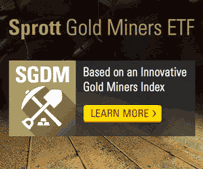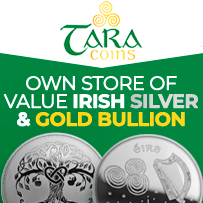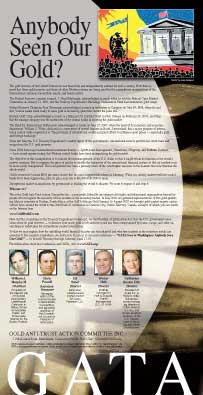You are here
Kelvin Williams urges transparency, then toasts keepers of gold's secrets
9p ET Friday, November 24, 2006
Dear Friend of GATA and Gold:
TheBullionDesk.com this week posted a long toast offered to the London Bullion Market Association during a dinner at Goldsmiths' Hall in London by the former marketing director of AngloGold Ashanti Ltd., Kelvin Williams, who retired this year. The text is appended and is remarkable for its insight into the gold business, its grudging recognition of GATA's work (if not quite by name), and, most of all, for its stunning self-contradiction.
Williams noted "the ferment of argument that thrives in gold" and "the vehemence of opposing opinion amongst its participants." But, he continued, surely with GATA in mind, "The polarised nature of this debate is not constructive for the industry, most particularly in respect of the accusations made by gold fundamentalists of massive fraud and manipulation of the gold market. ... It does no one's reputation much good to have an industry in which major producers and banks are sued unsuccessfully for price manipulation, or the governor of the Federal Reserve of the USA is accused of lying about US gold reserves, or the official sector generally is treated as misrepresenting the state of its gold reserves on official-sector balance sheets."
Whether "the accusations made by gold fundamentalists" are true or false, Williams' criticism of them was far from a denial or even a rebuttal. To the contrary, Williams' criticism was actually a refusal to engage in debate as well as a misstatement of fact. For Blanchard & Co.'s gold price manipulation lawsuit against Barrick Gold and J.P. Morgan Chase & Co., the successor to Reg Howe's lawsuit against the Bank for International Settlements, the U.S. government, and various bullion banks, a lawsuit underwritten by GATA, was actually QUITE successful, prompting Barrick's promise to stop shorting gold for 10 years.
Williams went on to lament the secretiveness of the gold business, which, he said, "pervades not only the reporting of selling and buying for investment, speculation, and official sector activity, but also for parts of the jewellery or consumer sector of the market, where the metal or the product is not infrequently smuggled between different tax regimes and sales are impossible to record. ...
"The gold business would be a stronger and more effective sector for the future if flows and stocks of the business could be more transparently reported, and there were more common-sense consensus or understanding of the business, which in turn might curb the propensity for conspiracy theories in this market. A common understanding of the gold business might also assist all participants to accept positively the multi-faceted nature of the market and to make sure that all aspects of gold's identity in different markets are properly appreciated, supported, and maintained."
This was just too much.
For the LBMA Williams was toasting is the very mechanism of secrecy in the gold market and, as Williams more or less acknowledged, the agent of the even more secretive central banks. Indeed, it was the LBMA that refused to make public the speech given to its meeting in Moscow in June 2004 by the deputy chairman of the Bank of Russia, Oleg V. Mozhaiskov, in which Mozhaiskov said he shared GATA's suspicion that the gold market was manipulated:
http://groups.yahoo.com/group/gata/message/2425
Rebuffed by the LBMA, GATA obtained Mozhaiskov's speech only after months of negotiation with the Bank of Russia and other intermediaries.
So much for transparency at the LBMA.
No doubt the LBMA people drank heartily to Williams' toast -- after they stopped snickering to themselves. Maybe Williams was snickering himself and his toast was just a little inside joke with his banker friends. After all, if Williams had been sincere in his call for transparency in the gold market, he would have had to throw his glass at them, and a few bottles too.
CHRIS POWELL, Secretary/Treasurer
Gold Anti-Trust Action Committee Inc.
* * *
Toast to the London Bullion Market Association
Proposed by Kelvin Williams
Former Marketing Director for AngloGold Ashanti Ltd.
LBMA Biennial Dinner
Goldsmiths' Hall, London
November 2, 2006
http://www.thebulliondesk.com/Content/reports/tbd/temp/Biennia_%20Dinner...
In the just over 20 years of my employment in the gold business, I can think of no event that has given me greater pleasure and greater honour than the invitation by the members of the LBMA to be your guest of honour this evening and guest speaker. Thank you.
Thank you also to Dr. Stewart Murray, who not only framed the invitation to me but followed up with deep and meticulous loyalty to the interest of his association with an email detailing all the nice things that he'd like me to report this evening on the affairs of the LBMA.
Instead of offering you a review of the LBMA and of your own business, I though that I would comment rather on the unusual nature of the gold market, and on some of the issues that arise from the nature of this market, before arriving, inevitably, at the LBMA.
How different are we from these other commodity and currency markets?
Without doubt our market is an exceptional creature in the worlds of either commodities or currencies in which we are fellow travellers. We were a globally traded good with all of the characteristics of a currency market with respect to liquidity and pricing long before the base metals of this world ever escaped the confines of the London Metals Exchange contracts, and gold has performed the role of complementary trade to the US dollar market for over a quarter of a century.
Unlike other commodities, gold is practically never consumed or destroyed, and the majority of all gold ever mined still exists in one form or another in the world today. GFMS estimates that there are above-ground stocks of some 156,000 tonnes, equal to almost 40 years of gold offtake in today’s market, or 62 years of current annual new mine production of gold. No other major commodity faces this kind of market, where above-ground stocks annually provide over a third of metal supplies to meet market demands, and where policy decisions by institutional holders of gold or private investment decisions can directly affect the market and price of the metal. It may be that the size of this non-mining supply to the market contributes to the attitude that many gold mining companies have of no responsibility for the market for the metal that they produce. I will address this later.
Another distinctive feature is that the balance of supply and demand for the metal plays only a minor role in the pricing of the metal. This is a market where price direction is determined largely by investors or speculators in the derivative sector of the gold market, and not by physical consumers or physical sellers of the metal.
Nevertheless, physical demand does play an important role in supporting a floor price for the metal in times of weaker markets, and physical demand certainly saved the price of the metal repeatedly in the 1990s. Although not the critical price determinant, it does also from time to time encourage sentiment one way or another in the investment sector.
The final distinctive feature that I want to mention is the residual or quasi-monetary nature of gold and how it trades.
We should not forget that the regulated and monetary nature of the gold market and the role of central banks as primary buyers of gold for reserve purposes endured until as recently as 25 years ago.
The residual characteristics of gold as money take many forms, from the continued strong commitment by central banks such as the Banque de France and the Swiss National Bank to holding a portion of national reserve assets in metal, to the farmer in Rajastan who converts the proceeds of his enterprise into a gold bar as soon as monsoon is over and the harvest is in.
Sometimes the acknowledgement of gold's unique monetary value is a little more oblique and Freudian perhaps, and I shall always cherish a letter written to me by an enterprising gentleman from Italy in the late 1980s proposing some scheme or other for us to supply him with gold bullion, which proposal he signed off with the salutation, "I thank you a loot," which seemed to sum it all up.
The role of gold as money or as a store of value is reflected in its responsiveness to currency value movements and to other economic indicators. This pricing of gold is captured daily in the headlines of market reports by every leading bullion bank or gold analyst, and I quote, verbatim, from early August headlines:
"Gold falls sharply on US dollar rally, on oil decline and easing geo-political tensions."
"Gold extends decline prompted by US dollar gains."
"Higher oil prices reverse gold losses."
"Gold bounces on combination of weaker US dollar and surging oil prices."
Followed immediately by:
"Gold retreats on US dollar rally and less-bellicose than expected response by Iran to the UN."
After all that, it was a relief to see John Reade's headline of 24 August 2006 that read: "Precious metals confused."
A related aspect of this residual monetary characteristic has been and remains the confidential or secretive nature of most stocks and trade in gold, both absolutely and in comparison with trade and trading in other commodities, from coal to copper.
This secretiveness pervades not only the reporting of selling and buying, for investment, speculation, and official-sector activity, but also for parts of the jewellery or consumer sector of the market, where the metal or the product is not infrequently smuggled between different tax regimes and sales are impossible to record.
An amusing manifestation of official and consumer product secrecy occurred at a gold conference in Vienna in the early 1990s where, for the first time, such a conference was attended by a Russian delegate, one Ulyanov (I think) from Vneshenkonimbank. Mr. Ulyanov delivered a short but largely impenetrable speech on gold in Russia, telling delegates little if anything, and when asked the question of whether he knew what annual gold consumption in jewellery in Russia was, he stood up, took the microphone, answered with a firm "yes," and sat down again.
These particular aspects of the gold market -- all too familiar to you here this evening -- have consequences for the behaviour of gold market participants, and I would like to touch on a couple of these as issues that I believe would benefit from some effort by the industry to manage and address rather better in the future than has been the case in the past.
The first of these issues is that the monetary role of gold and the intermediary role of the bullion banks have in effect separated almost all gold producers entirely from any real customers for, or consumers of, the metal they produce. Although some 80% of annual gold consumption goes into gold jewellery, most gold mining companies have never met a jewellery manufacturer or retailer. Although India is responsible for almost 20% of all gold offtake annually, most gold mining companies have never visited the Indian market.
Gold mining companies must be unique in this world for producing a good for which they never actually go out and find a customer. Bullion banks take gold from the mining companies, finance it as inventory, and on-sell it to the fabrication and investment markets.
Inevitably, perhaps, this break between the producers and the real market for their metal leads to a carelessness amongst most gold producers about the state of the physical market for their product in a way inconceivable in any other commodity market -- and particularly in the markets of our direct competitors, platinum and diamonds. Since the bullion bank is always there as middleman, in times of weak or strong demand, why have any concern for the health of the market?
Amongst the broader gold market players, the official sector makes its contribution to the health of the market through the orderly selling programme of the Washington Agreement. The gold jewellery manufacturing and retailing sectors, whilst they assist usefully to promote gold in co-operative activities led and managed by the World Gold Council, cannot themselves be relied upon to lead the promotion of gold for the reasons that they are fragmented and divided industries, and they have conflicting loyalties to gold, being sellers equally of silver jewellery, diamonds, coloured stones, and so on.
Only the gold mining company has the sole and undivided interest in championing the metal and promoting the health of the gold market. Regrettably, this reasoning does not prevail in the gold mining sector.
Fortunately, this attitude is not held by all gold producers. The members of the World Gold Council, most particularly Newmont, Barrick, Gold Fields, and AngloGold Ashanti, have borne the responsibility over years for funding the promotion of gold, as well as new members of the council, such as Kinross, IAMGold, and Goldcorp, and take seriously their responsibility for the health of the market.
But well over 50% of gold producers do nothing for their metal except mine it and dump it, and it would be a salutary lesson to all of them if the members of the LBMA were to go on holiday for a month or three and let this sector produce a form of metal product that end-customers actually want, find their own buyers, manage their own credit exposures to these buyers, transport and insure their metal to the customer, and so on.
Perhaps the closest example that we have of a company in the gold producing/refining sector that straddles the divide between basic metal and the end-market consumers in gold is the Pamp refinery and MKS business out of Switzerland, where relations with gold customers in important gold-offtake markets are managed as a core activity of the business, and where gold product offers are constantly adjusted and evolved to meet the changing demands of existing customers and to attract new customers.
It must be a pity that gold producers themselves do not pay as much attention to the metal which is their sole bread and butter as does a Pamp.
The second issue which arises from the monetary nature and unusual confidentiality of the gold business is the diversity of views of the metal and the market for gold that a non-transparent market gives rise to, from the extremes of those who believe passionately in gold only as money and as investment, to those on the opposite end of the spectrum who would have gold compete more successfully for consumer market share against platinum, coloured stones, and diamonds.
In no other commodity market (or foreign currency market for that matter) does one have the ferment of argument that thrives in gold, nor the vehemence of opposing opinion amongst its participants. The differences between hedgers and non-hedgers, between those who believe in gold as money and those who see gold as a commodity, between those who believe that bullion banks are the source of all evil in tempting innocent mining companies to hedge their product and those who see bullion banks as bullion banks and so on and so on. One is put in mind of J.K. Galbraith's anecdote about the ferment of social and revolutionary debate at the turn of the last century, particularly in central Europe and Russia, such that Geneva landladies had two different room rates -- one for ordinary people, and another, higher rate for Russians who would sit up all night arguing. (The hotel trade might usefully note this for the next LBMA conference.)
However, the polarised nature of this debate is not constructive for the industry, most particularly in respect of the accusations made by gold fundamentalists of massive fraud and manipulation of the gold market.
The so-called gold bugs have some valid views about gold, and their great loyalty to the metal is not irrational. Gold has unique characteristics, as a metal with unique and useful metallurgical properties, as an object of physical beauty, and as a uniquely long-standing medium of exchange and arbiter of monetary good health in human society. Gold is a wonderful metal and the most passionate advocates for the metal have remained loyal to gold through difficult times and I would share many of their views about gold.
However, it does no one's reputation much good to have an industry in which major producers and banks are sued unsuccessfully for price manipulation, or the governor of the Federal Reserve of the USA is accused of lying about US gold reserves, or the official sector generally is treated as misrepresenting the state of its gold reserves on official sector balance sheets.
As a further irrational product of some of the extreme views on gold, the work of the World Gold Council is dismissed by some of these commentators as damaging to the interests of gold because it applies its resources in part to the promotion of gold in jewellery rather than concentrating solely on investment and monetary gold sectors.
You can image how much less effective the marketing activities of our competitors in platinum and diamonds might be if they had to deal with multiple and conflicting loyalties to their products.
The gold business would be a stronger and more effective sector for the future if flows and stocks of the business could be more transparently reported, and there were more commonsense consensus or understanding of the business, which in turn might curb the propensity for conspiracy theories in this market. A common understanding of the gold business might also assist all participants to accept positively the multi-faceted nature of the market and to make sure that all aspects of gold’s identity in different markets are properly appreciated, supported and maintained.
The World Gold Council has straddled this multi-faceted market with Olympic-class effectiveness in combining its core gold jewellery promotion activities with the creation and launch of gold ETFs in the investment sector over the past three years, creating the single most effective and successful gold investment initiative in gold in 21 years since the Krugerrand. One would hope that their success might inspire all players in our market to lend more support to gold.
As a small digression, the same appeal for good sense would apply to the debate on hedging in the gold mining industry. Gold producers over the years have sold production forward for the simple, good-sense reason of reducing revenue risk and removing uncertainty in a vital part of the mining business. Over this central reason can be laid such company-specific reasons as protecting a capital expenditure programme or securing borrowing for projects in high-risk areas of the world.
Believe it or not, there are investors in the gold mining sector who understand the rationale for revenue management and who are keen to see a company run as a company, not simply as an option on the gold price.
However, the debate on hedging has been driven not by such investors but by a more fundamentalist gold constituency, and along less than rational lines, as reflected in a letter by a leading name from the gold fundamentalists who wrote in 2000 to certain gold mining companies with forward sales, referring to their "cyberspace, non-regulated, non-transparent market devoid and possibly non-existent 'iron pyrite' paper gold so-called hedges."
The basic view that gold mining companies ought not to hedge because a certain category of investor wants unmediated exposure to the gold price contains a major flaw. Such a demand throws up a conflict between the interests of this particular category of shareholder and the broader interests of the gold company including both its shareholder body and all other stakeholders. An anti-hedging shareholder can quit the shares of a gold company the moment the gold price weakens and will face none of the downside of weaker market conditions having sold his shares.
The gold mining company will continue to exist, however, and must manage its business as best it can in such a market, with or without price certainty or price protection. The gold investor is out; the gold mining company remains in. This sobering reality should place the anti-hedgers' demand in some perspective.
Of course, the argument of the gold fundamentalists is that the gold price should always trend upwards, given the fundamental worthlessness of fiat currencies, and therefore gold producers will always be protected by higher prices. (And, of course, the corollary of this view being the conspiracy theory that if the gold price doesn't go up, it must be due to manipulation of the market.)
I'm afraid that I've never set much store by overconfident forecasts of prices, and have seen too many prices views and too many analysts' forecasts which have been wrong and remained wrong for extended periods of time.
Equally, the argument that hedging by gold mining companies somehow uniquely depressed the gold market in the 1990s has to be simply nonsense. Gold mining sector hedging and borrowing brought to the market at its peak an amount of some 4,000 tonnes of gold over the 15 years from the mid-1980s. By comparison, incremental and new project gold mining production over the 20 years from 1980 brought to the market almost 21,000 tonnes of additional gold sales during this time. I leave it to you to decide which of these two weighed more heavily on the market and on the price over time.
The most telling argument against hedging for gold miners today is rather the fact that accounting rule changes flowing from the massive frauds in leading US corporations five years ago have made accounting treatment of hedges for commodity producers a complex and almost unmanageable process. The difficulties faced by gold mining companies in this area are not reduced by an accounting profession that appears to be unwilling to give constructive advice and leadership. Accounting whimsy alone would justify gold producers foreswearing future hedges.
And now, finally, we come to the bullion banks who underpin this world of gold. The unsung -- not heroes, but certainly colleagues-in-arms of the global gold business, and their institutional home, the London Bullion Market Association.
I don't intend, I'm afraid, to do what Stewart suggested -- to outline the evolving importance of the association in a non-hedging gold market, its powerful central role in the massive flows of the interbank business, its importance in setting the rules of the game for the modern business in physical gold. That report on your very reputable association I shall leave to your chairman or chief executive officer to present.
Instead, to conclude, what I intend to do is to return to my earlier observation about the bullion bank as the backbone of the gold market and gold physical distribution in the global business.
We, the gold mining companies, see one face of the bullion banking business, and the attitude of the gold mining sector is too often a dismissive one. I believe that the mining industry often misses the vital role played by the members of this association, both in making the market for our metal but also in your custodianship and professional handling of many of the standardisation and quality issues of central importance to the sustainable and effective conduct of the market for the gold that we mine and produce.
I believe that those who see the bullion banking sector as simply another service industry out to profit from the mining industry miss the point of the bullion banks and their full role in the gold business, and that they certainly fail to enjoy the full benefit that the bullion banks offer in our business. For they not only sell services and manage many of the processes of the gold market for sellers and for buyers -- they provide advice, views on the market, and a window on those parts of the market for our metal that we would otherwise never see, from small bar demand in Mongolia to views on the Bundesbank and ECB interest rates.
And in closing I would like to record one final personal gratitude, to all the remarkable individuals in this association who have enriched my understanding of this gold business, who have explained to me the more arcane parts of what they do, and who have taken risks in the gold business on the basis of relationships in a pre-Enron world that hardly survives today. You are a remarkable community, and you cover the world of bullion in a manner that no other sector of our business does -- servicing central banks in the gold market, looking after mining clients, dealing with bullion traders and middlemen and regional banks from Turkey to China, managing the inventory financing for jewellery manufacturing clients -- a sort-of London Underground map of the global gold business.
Thank you to Stewart Murray, and to all my bank friends and counterparties, from Fritz Plass of Deutsche Bank who taught me so many things so long ago, to the wonderful Rothschild team of the early 1990s, to Martin Stokes of Morgan and to so many others who I would mention if I had a little more time.
Because you're all part of this same sector, you may not understand quite how unusual your business is compared with other businesses, or quite how interesting a bunch of people you are. I have been enormously fortunate to have spent 20 years of my working life amongst your members, Mr. Chairman, and I am grateful and honoured to have this opportunity to propose a toast to your association.
Ladies and gentlemen, may I ask you to be upstanding and join me in a toast to the future health and prosperity of the London Bullion Market Association.
Thank you.
* * *
Join GATA
at the
2007 Vancouver Resource Investment Conference
Vancouver Convention and Exhibition Centre
Sunday and Monday, January 21 and 22, 2007
http://www.cambridgeconferences.com/ch_jan2007.html
Admission is free for those who register in advance. The conference has arranged discount rates at the Pan Pacific Hotel adjacent to the convention center.
* * *
Help Keep GATA Going
GATA is a civil rights and educational organization based in the United States and tax-exempt under the U.S. Internal Revenue Code. Its e-mail dispatches are free, and you can subscribe at www.GATA.org. GATA is grateful for financial contributions, which are federally tax-deductible in the United States.








